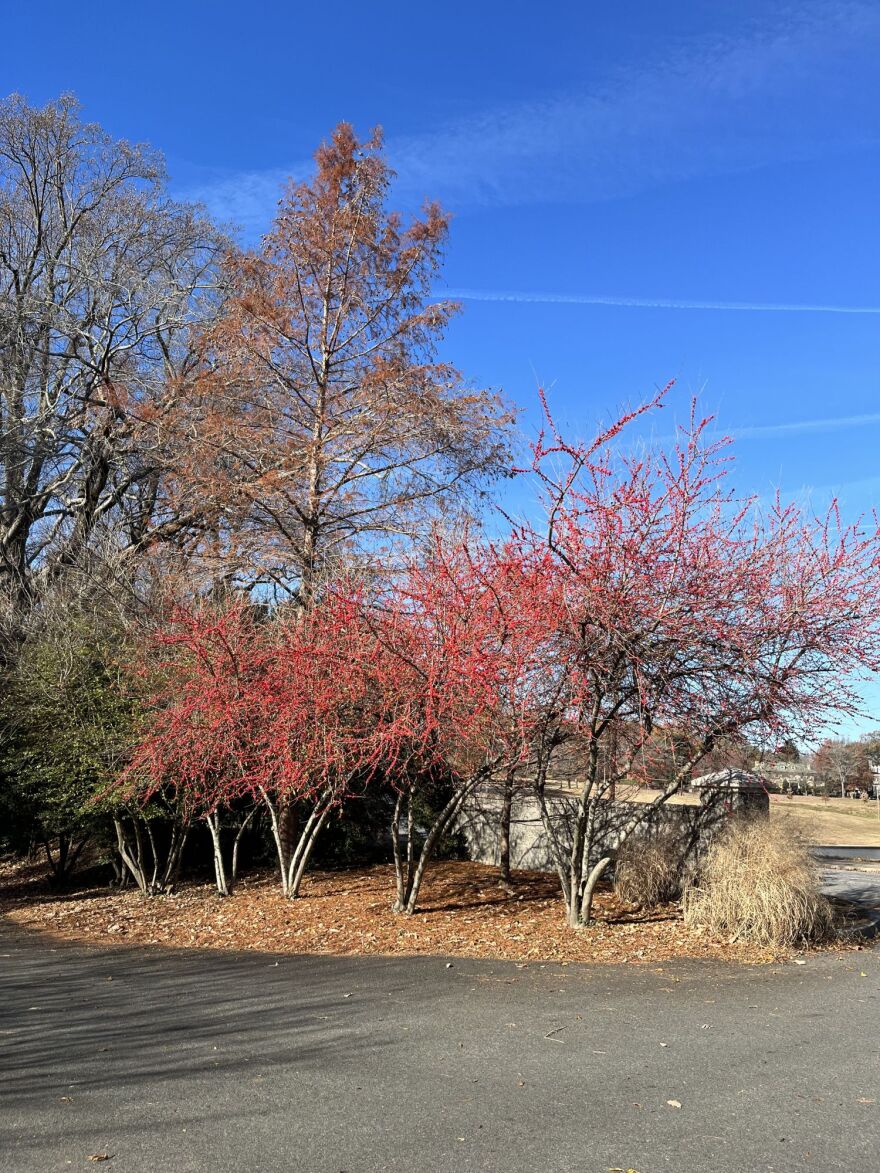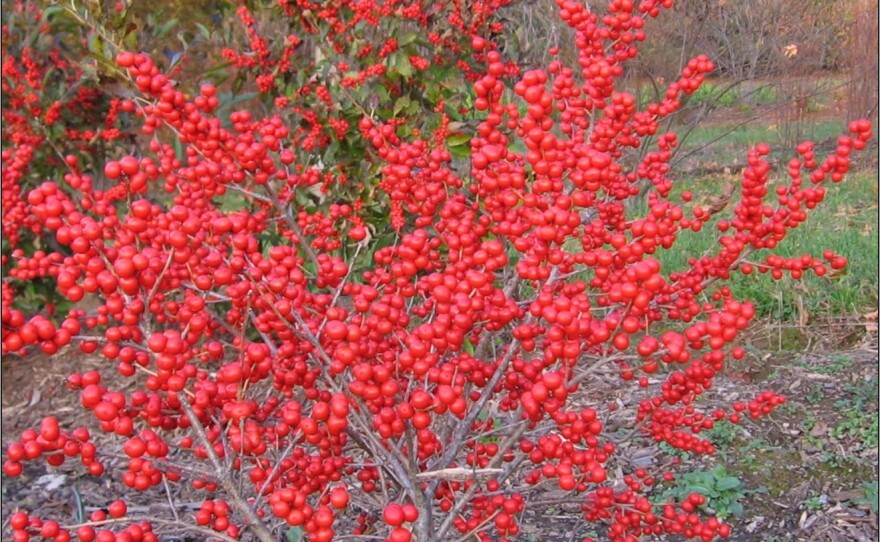After tucking in my gardens with the leaves I raked from the yard, I take another walk around the landscape to check out the garden in winter. With winter firmly ensconced, the bones of the different gardens are revealed. Questions run through my mind as I walk about the various plantings. In each individual bed, are there enough evergreen plants to visually carry to space for the next few months? If there are plant support structures in a garden, are they sound and straight? What else needs to be done to the winter garden so it presents well? Finally, I assess my landscape for color. Which plants will provide color in the garden during the winter?
Typically, winter color is attained through plants that produce berries, although some evergreen plants have colorful needles and leaves while other plants have colorful bark or branches. The joy of adding berry producing plants to the garden is found not only in their beauty but in the birds they attract. Did you know native plants typically attract more birds to a garden?
When gardeners think of berries they often think of heavenly bamboo, Nandina domestica, a plant I am not a fan of. While the berries of this non-native plant do add winter color, they also contain cyanide — a known poison. The other reason I don’t care for the plant is the berries have a high germination rate and grow where they fall. People say they grow them for holiday decorations but in reality, the red berries fall off quickly after the wreath or greenery décor has been hung. For winter color, I encourage gardeners to step away from the nandinas and turn toward our Virginia native deciduous hollies, junipers and viburnums.
For red in the winter garden, it’s difficult to beat Ilex decidua, possomhaw holly, or Ilex verticillata, winterberry. The bright red berries of these deciduous shrubs line the stems of the upright growing plants. Possomhaw holly can grow up to 30 feet, depending on the cultivar. Hardy to zone 5 this plant thrives in moist to wet soils. While winterberry holly can grow between 5 to 15 feet tall, again depending on the cultivar, and can tolerate drier growing conditions. Surprisingly this shrub is hardy from zone 3 to zone 9. Both plants are hollies and like the American holly, Ilex opaca, are dioecious, meaning, male and female flowers are on separate plants. For berries to be produced on the female flowering plants there must be a male flowering plant close by to pollinate it. Within both species there are different varieties which grow to different heights. The corresponding male variety needs to bloom the same time the female variety does for pollination and berry formation. For good berry turnout the ratio is about 1:5 — one male shrub for every five female shrubs. The male plant can be planted in a different location within your landscape, it does not have to be next to the female plants. For example, my Ilex verticillata ‘Red Sprite’ needs Ilex verticillata ‘Jim Dandy’ to pollinate its flowers. I consider ‘Red Sprite’ a great plant for the landscape because it is slow growing to a height of 3 to 5 feet tall, depending on the soil conditions, and it produces a plethora of red berries if ‘Jim Dandy’ is nearby!

Ask the professionals at your local garden center for the complimentary male plant to the female deciduous holly you plan to purchase.
Other red berried plants are Chokeberry, Aronia arbutifolia, American cranberry bush, Viburnum trilobum, crabapple, Malus spp. and hawthorn, Crataegus spp. And don’t forget the native evergreen ground cover, partridgeberry, Mitchella repens. Unlike hollies, these plants have both male and female flower parts on the same plant, some even the same flower. However, for maximum berry production and impact in the landscape it’s best to grow two or more of the same for cross pollination.
While red berries brighten the landscape blue and black berries plants also add color. The beautiful blue colored cones of our native Eastern red cedar, Juniperus virginiana, glow in the sunlight. Like hollies, junipers are dioecious, the female cone producing plant needs a male cone producing plant nearby for pollination. Eastern red cedars have different varieties, and a favorite of mine is Juniperus virginiana ‘Emerald Sentinel’. This narrow-growing, dark-green evergreen will grow to 15 feet in 10 years yet only 5 feet wide. Each year, it is covered in blue cones if there is a male juniper nearby.

Arrowwood viburnum, Viburnum dentatum, is another plant which adds color to the winter landscape with its dark blue berries. This deciduous shrub has many cultivars of varying heights and fall leaf color. For berry production it is necessary to choose two different cultivars that bloom at a similar time for cross pollination. This is because viburnums are not self-fertile, which also means you cannot plant two of the same variety or cultivars. Again, ask your local garden center professional for advice on which two varieties to plant in your landscape.
Gardens and landscapes add to our well-being, and including plants that produce berries is a great way to brighten the winter garden. I hope you consider the few I have mentioned here.
Happy Gardening!
Peggy







